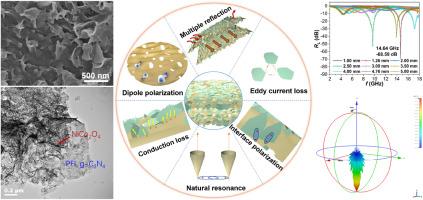Construction of 2D/2D heterostructure with porous few layer g-C3N4 and NiCo2O4 nanosheets towards electromagnetic wave absorption
IF 8.2
2区 材料科学
Q1 MATERIALS SCIENCE, MULTIDISCIPLINARY
引用次数: 0
Abstract
Developing high-performance materials with ultra-high reflection loss (RL ≤ −65 dB) for electromagnetic wave (EMW) absorption is pivotal to address electromagnetic pollution, but it is still challenging. Herein, a two-dimensional (2D)/2D PFL g-C3N4/NiCo2O4 heterostructure with porous few-layer g-C3N4 (PFL g-C3N4) and ultrathin NiCo2O4 nanosheets has been prepared by self-assembly, hydrothermal reaction, and calcination strategies. The 2D/2D heterostructure exhibits extraordinary EMW absorption property, achieving a reflection loss (RL) value of −68.59 dB and an effective absorption bandwidth (EAB) of 1.92 GHz at a matching thickness of 2.5 mm. As expected, the porous few layer g-C3N4 nanosheets provide rich interface which increases multiple reflection paths and enhances the conduction loss. The cooperative effects of magnetic loss, dielectric loss, and impedance matching contribute to the exceptional EMW absorption property of PFL g-C3N4/NiCo2O4 (2D/2D) heterostructure. The potential of PFL g-C3N4/NiCo2O4 in actual radar stealth is verified through radar scattering cross-section (RCS) simulation. This work paves the way for utilizing 2D/2D heterostructure as an ultra-efficient EMW absorbers.

利用多孔少层 g-C3N4 和 NiCo2O4 纳米片构建二维/二维异质结构以吸收电磁波
开发具有超高反射损耗(RL ≤ -65dB)的高性能电磁波(EMW)吸收材料是解决电磁污染问题的关键,但目前仍面临挑战。本文通过自组装、水热反应和煅烧策略制备了一种具有多孔少层 g-C3N4(PFL g-C3N4)和超薄 NiCo2O4 纳米片的二维(2D)/二维 PFL g-C3N4/NiCo2O4 异质结构。这种二维/二维异质结构具有非凡的电磁波吸收特性,在匹配厚度为 2.5 毫米时,反射损耗(RL)值为 -68.59 dB,有效吸收带宽(EAB)为 1.92 GHz。正如预期的那样,多孔的几层 g-C3N4 纳米片提供了丰富的界面,从而增加了多条反射路径并提高了传导损耗。磁损耗、介质损耗和阻抗匹配的共同作用使 PFL g-C3N4/NiCo2O4 (2D/2D) 异质结构具有优异的电磁波吸收特性。通过雷达散射截面(RCS)模拟验证了 PFL g-C3N4/NiCo2O4 在实际雷达隐形中的潜力。这项工作为利用 2D/2D 异质结构作为超高效电磁波吸收体铺平了道路。
本文章由计算机程序翻译,如有差异,请以英文原文为准。
求助全文
约1分钟内获得全文
求助全文
来源期刊

Materials Today Nano
Multiple-
CiteScore
11.30
自引率
3.90%
发文量
130
审稿时长
31 days
期刊介绍:
Materials Today Nano is a multidisciplinary journal dedicated to nanoscience and nanotechnology. The journal aims to showcase the latest advances in nanoscience and provide a platform for discussing new concepts and applications. With rigorous peer review, rapid decisions, and high visibility, Materials Today Nano offers authors the opportunity to publish comprehensive articles, short communications, and reviews on a wide range of topics in nanoscience. The editors welcome comprehensive articles, short communications and reviews on topics including but not limited to:
Nanoscale synthesis and assembly
Nanoscale characterization
Nanoscale fabrication
Nanoelectronics and molecular electronics
Nanomedicine
Nanomechanics
Nanosensors
Nanophotonics
Nanocomposites
 求助内容:
求助内容: 应助结果提醒方式:
应助结果提醒方式:


